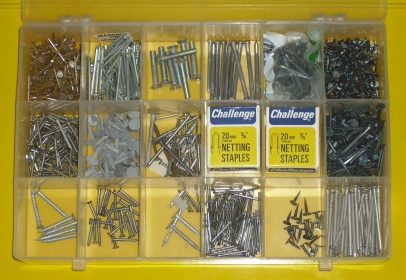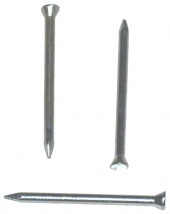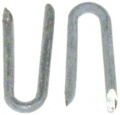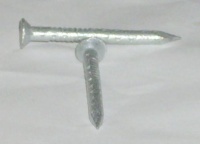Difference between revisions of "Nails"
(pic tweak) |
(→Nail Plates: pic) |
||
| Line 135: | Line 135: | ||
==Nail Plates== | ==Nail Plates== | ||
| − | [[image: | + | [[image:Nailplate 3029-3.JPG|right|250px]] |
A metal plate with many spikes formed on one side | A metal plate with many spikes formed on one side | ||
| Line 144: | Line 144: | ||
* Can a sledge[[hammer]] be used? | * Can a sledge[[hammer]] be used? | ||
* Spikeless nail plates are also available, as shown. These just have holes, nails are hammered through the holes by hand. | * Spikeless nail plates are also available, as shown. These just have holes, nails are hammered through the holes by hand. | ||
| − | |||
=Roofing Nails= | =Roofing Nails= | ||
Revision as of 20:59, 19 November 2009
Top row:
- Round wire nails
- masonry nails
- -
- oval nails
- carpet tacks
- carpet tacks
Middle row:
- asstd pins
- clout nails
- -
- fencing staples
- carpet tacks
Bottom row:
- plasterboard nails
- ring shank nails
- asstd
- ?panel pins
- carpet tacks
- round wire nails
Construction Nails
Round Wire Nails
Planet Earth's most popular nail.
- Low cost
- Quick to use
- Blunt the point with a hammer to reduce risk of splitting when nailing near an edge.
Oval Nails
As round wire nails, but:
- Less likely to split wood
- More likely to bend when hammered
- Cost a bit more
Ring Shanked Nails
- More resistance to pullout.
- Used for wooden flooring
- Nail guns often use these to compensate for using thinner gauge nails
Brads
- Smaller nails, under 1.25"
Masonry Nails
These can be hammered into masonry, unlike most other nails. They are hardened steel.
There is one problem with these. The masonry is hard, and does not want to be nailed. The Nail is hardened, and does not want to bend. Something has to give. What usually happens is the nail flies off repeatedly at unpredictable angles and at high speed. Eye protection is a must.
Some of the time they fly away with almost no resistance, so the travelling hammer head continues onto your fingers at almost full speed. Bear in mind these nails need to be hit relatively hard to get anywhere, and you can see why masonry nails have become unpopular.
The solution is easy enough. Always hold the nail in pliers, always use eyewear, and don't let anyone without eyewear be in the room when you're nailing.
Using pliers gets your hands out the way, and it also impedes the flying habit of the nails. They still fly sometimes, but the friction from the pliers makes them fly slow instead of going off like unguided missiles.
Cable clip nails are small masonry nails. The plastic clip stops them flying.
Screws
Screws can also be hammered in like nails.
- Damages the wood to some extent
- Good pullout resistance compared to most nails
- Harder to drive
- Prime app is nailing down chipboard flooring. The soft chip makes them hammerinnable, and the pullout resistance helps avoid creaking and lifted boards.
Staples
- U shaped nails and [ shaped both available
- U shaped staples are used primarily for wire fencing
- [ shaped mainly used to fix thin sheet materials
Cut Clasp Nails
- These nails are cut from sheet metal
- Tapered sides
- Better grip in softer materials
- The cut end tears the fibres of the wood on entry rather than pushing them apart, so they are much less likely to split the wood when used near the edge. Hence their popularity as floor board nails.
Square Twist Nails
- Improved pullout resistance in spingy materials such as wood
- Usually specified for use with joist hangers
Lost Head Nails
Nails with very small heads that are designed to be hammered flush with the surface or slightly countersunk. Once inserted they are almost invisible. Ideal for fixing decorative trim on furniture, and for temporary holding of parts while glue dries.
Grooved Nail
- Less weight per nail
- more cost per nail
Spiral Nails
- Look quite like twist drill bits
- High pullout resistance in soft springy materials such as wood
Collated Nails
Designed for use in nail guns, they consist of a strip of nails glued side by side such that they can be autofed into the nailer. Some strips are simply held together with glue or lacquer. Bigger framing nails may be joined with glued paper or plastic strips. The strips are designed to break away from the nail as it is fired.
There are several types:
- Round head - similar to conventional wire nails
- clipped head - often used with nail strips designed for use in guns with a swept magazine like framing nailers. Typically a half moon section is missing from each nail head to enable the nail to slide past the next one in the strip more easily.
- T shaped head - like mini cut clasp nails in a strip. Used for floorboard fixing, some masonry and roofing material fixing applications.
Casing nails
- nails with a smaller head.
- For flooring & other apps where large nail heads are not wanted.
Spikes
Nails over 4" are called spikes
Nail Plates
A metal plate with many spikes formed on one side
- For wood, mainly used in roofing structures
- Extremely tough grip
- Requires a press to insert them
- Can a portable press be used?
- Can a sledgehammer be used?
- Spikeless nail plates are also available, as shown. These just have holes, nails are hammered through the holes by hand.
Roofing Nails
Copper Nails
- Used for fixing roofing slates
- Less prone to corrosion than steel nails
- Large heads
- Cost more
- Softer metal
- Copper prevents lichen & moss growth, reducing cleaning requirements
Clout Nails
- Short wide head nails
- Used for felt roofing
- handy whenever a large head is needed
Cone Head Nails
For metal & plastic roofing
Spring Head Nails
For roofing
Plastic Head Nails
- Soft plastic head
- For plastic roofing, and fixing uPVC facias.
Pins
Panel Pins
Very small nails with very small heads
Headless Pins
Headless or finish nails & pins have no head, minimising their visibility in the finished workpiece.
Special Purpose Nails
Carpet Tacks
- The thin point on carpet tacks bends over when inserted, giving pullout resistance.
- The dark head gives minimum visibility
- The sharp point goes through carpet easily.
- Tacked carpet has a vertically wavy edge if the carpet is folded over, or a raw cut edge if not. Neither is ideal.
- Tacks can pierce wires or pipes
- Tacks are cheaper to buy than gripper rod, but fitting is slower
- Gripper rod is almost always preferred.
Plasterboard nails
- For fixing plasterboard to timber framing
- Poor performance compared to plasterboard screws
- Other profiles than the one shown are also seen
- Not often recommended these days
Capping nails
- aka Mickey pins
- built in washer
- for fixing electrical capping
Upholstery Pins
Other Nail Types
- Bullethead nail
- Corrugated nail
- D head nails
- Horseshoe nail
- Hurriquake nail
- Plastic strip nails
- Gutter spikes
- Fibre cement nails
- Box nails - thinner than standard wire nails
- CC nails - adhesive coated nails for better grip
- Duplex nail - has a 2nd head for easier extraction
- Veneer Pin
Materials
Nails are made of:
- Steel
- Stainless steel
- Brass
- Copper
Finishes
- Bright or BZP (bright zinc plated) steel.
- Galvanised
- Sheradised
- Brassed
- Coloured head
Techniques
Finger survival
Holding nails in pliers increases average finger life. Alternatively hold between the sides of two fingers with the knuckles facing the work. If you do strike your fingers, it hurts much less.
Toe nailing
(Also called "Tosh nailing") Used for forming perpendicular joints in joinery like roofing and stud walls. Consists of nailing into the side of one piece of wood at around 45 degrees, such that the nail exits from the end grain of the wood and penetrates the wood to which the end is abbuted. Frequently used to fix vertical studs to the horizontal header or sole plate, and for fixing one end of noggings when they need to all be inline. The method is prone to moving the first piece of timber out of line.
Oversize Nails
If the only nails you've got to hand are too long, if the width isn't excessive and appearance doesn't matter, insert the nail to the required depth then knock the head over sideways.





